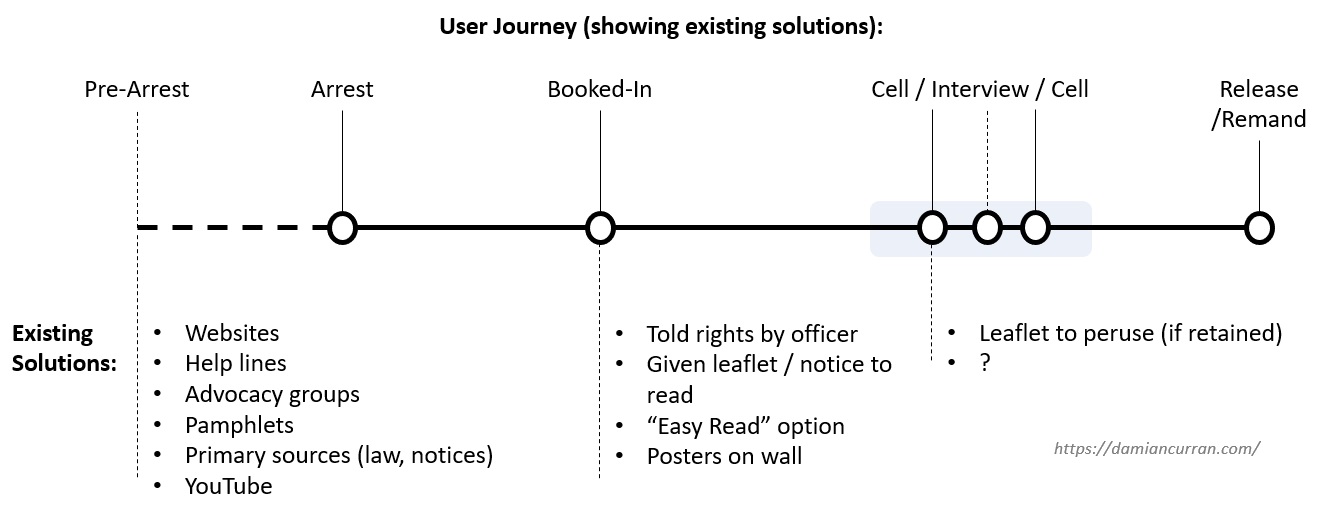This post explores the Legal Design Sprint process. It follows the development of what became a low-tech tech, practical solution to communicate legal rights to someone who has been arrested by the police. I highlight the benefits of the Design Sprint process, in particular the gains from user feedback and iteration and of operating in a multi-disciplinary team. I also suggest that there are limits to addressing long-standing access to justice problems in a ‘sprint’ environment.
[This post now been re-published on the Legal Design & Innovation publication on Medium]
Legal design sprints
A design sprint is a condensed, structured application of the design process to a given problem. A ‘legal’ design sprint is made so by its application to problems within the law – its institutions, services and accessibility.
The precise ingredients of the legal design process vary, but typically include empathising with a ‘user’, studying the user journey and its pain-points, creative brainstorming and developing solutions iteratively based on user feedback.
I recently participated in a Legal Design Sprint. In this post I explore, from conception to development, the process applied to an access to justice problem. I explore the evolution of what (I hope) may be a cost effective, low-tech and practical solution to our given problem, but also extract some general lessons about the legal design process and its efficacy.
The problem
The problem was “how to communicate the police powers, rights and safeguards set out in Part V of the Police and Criminal Evidence Act 1984 (PACE), to the widest possible audience, at the moment of need?”
Part V of PACE governs the rights and safeguards of people in police detention in the United Kingdom, such as the right to legal advice and to have someone notified of your arrest, and places limits on searches, finger printing and questioning of detainees. The problem, in other words, was to help people understand their legal rights whilst they are being detained.
Users & journey
Legal design typically involves the identification of a “user” and their “journey”. In the context of the often harsh, sometimes violent and mostly involuntary experience of being arrested, these terms are somewhat euphemistic. Nonetheless, in keeping with the parlance of legal design, the terms were adopted for this exercise.
Our “users” were people who have been arrested in the UK. Their “journey” follows the user from the moment of arrest to their release or remand. (These are not the only “users” affected in this policy space. Police officers are also directly affected and, were this exercise more of a marathon and less of a sprint, their perspective would have been considered also.)
Statistics were key to identifying our users. Luckily for our purposes, the UK Office for National Statistics collect figures on every arrest made by the police in the UK. The statistics are published annually. In the 2017/18 reporting year, there was just shy of 700,000 persons arrested in the UK. Our brief was to look at “the widest possible audience”, so we developed personas principally around the majority. The most prevalent attributes amongst the arrested persons in the UK, in absolute terms, were white, adult men, arrested for violent crime. (White men are over-represented users in so many other design endeavours, but in this particular instance they are an overwhelming majority far in excess of their prevalence in the population at large, and couldn’t reasonably be disregarded.) Unfortunately the reported statistics shone no direct light on language ability, disability, or place of birth. These could be inferred from other data-sets and statistics on the population as a whole, but not with the same accuracy.
We also explored the emotional side of the arrest journey. Anecdotal evidence suggested that, overwhelmingly, people who were arrested felt vulnerable – be it scared, anxious, embarrassed or ashamed. This may affect their ability to retain information, in particular in the early minutes of the process.

We plotted the arrest journey based on a review of the primary legislation, and the trove of information about arrest processes on the web. The user journey is rigorously prescribed in the law, from the words to be spoken to an arrested person by the police, to the maximum length of detention. Aside from some movement between the cells and the interview room, it is a linear progression from arrest, to being ‘booked’ into custody, to the cells / interview room, and finally to release or remand. Its length, however, varies from 45 minutes to up to 36 hours.
Ideation
It became apparent early in the research phase that we were exploring well chartered territory. This has been an important and long-standing issue of human rights and public policy for generations. The Miranda rights in the US (“You have the right to remain silent …”), for instance, date back to the 1960s and lean on rights enshrined in early constitutional amendments. There are advocacy groups which seek to empower and educate about the arrest process across the common law world. There are various phone lines, websites and educational material freely available. Most importantly for our purposes, the UK’s PACE legislation itself, and its subordinate rules and codes of conduct, prescribe very particular procedures aimed at ensuring a person is informed of their legal rights when arrested.
It should be unsurprising that such an important public policy and human rights issue has been so thoroughly investigated already. But perhaps that is a broader lesson to heed for ‘design sprints’ or ‘hackathons’, especially in the access to justice space: Unless particular problem relates to a recently emergent phenomenon or law, finding genuine solutions is hard. There will be lots of solutions out there already. There will be many legal, regulatory, financial and cultural restraints finely balanced around the existing frameworks. That doesn’t mean that a design sprint won’t produce anything of value – but it will take a lot of effort, creativity and an acceptance that in many cases the impact may only be marginal. And it doesn’t mean that the sprint can’t also be an engaging and thought-provoking learning experience for its participants, should that be the goal.
Nonetheless, we brainstormed a number of prospective solutions. Some of the ideas floated we later accepted fell outside of the brief, as they did not convey the information to the detainee “at the moment of need”, such as education campaigns, advertisements and reporting changes. Others were marginal improvements to the existing solutions, such as updated visual guides and posters within the Police station lobby.
Solution selection
It was only after overlapping both the user journey, along with all existing solutions, that we identified a prominent gap within it:

Although the existing framework emphasises conveying rights of the arrested person upon arrest, it disregards ongoing reminders about these rights. Our user research indicated that many users feel vulnerable throughout this process. They may be stressed, intoxicated or confused when they first enter the Police custody. That is, however, when most of the critical information is conveyed to them. But it was the time after they are booked-in when the user can sit quietly, compose themselves and think, that their rights are not re-iterated to them, unless they happen to have retained the rights and entitlement leaflet.
Our idea for development was simple: a message written on the cell wall setting out certain PACE rights. The ‘technology’ itself was already in use in UK police station cells, but related to emergency assistance, and messages warning occupants about the cost of vandalism. The idea was to re-purpose these signs to convey information about legal entitlements instead.

We understood that the limited wall space, and the need for a minimum text size for visibility, meant that the word count at our disposal was limited. Further, as the text was in a police cell and therefore subject to vandalism, there would be limits on the physical material that could be used, and hence the limited availability of intricate graphic design, pictures, colours or fonts.
Development
Our first design is set out below, and included the following features:
1. Acknowledgement of the arrested person’s likely emotional state, based on our research;
2. Reference to certain key rights, including to legal advice, which may act as a conduit to eliciting further relevant rights (through a lawyer, or the leaflet / guide / codes of conduct). The entirety of the PACE legislation or codes of conduct could not possibly fit on the wall, or if they could, would be overwhelming to the reader;
3. Stencil font, assuming the sign was to be physically spray painted on the wall to avoid vandalism;
4. Logos to represent the nature of each paragraph, to aid its interpretation.

The development phase reinforced the benefits of a multi-disciplinary team. Our chosen idea for development could easily have drawn upon skills within graphic design (layout, font and logos), psychology (the appeal to, and navigation of, the arrested person’s vulnerable emotional state) and carpentry / interior décor / materials engineering (to determine the suitability of various materials that may be vandalism proof within a cell, at an appropriate price). Although the discipline is referred to as ‘legal design’, in that it is applied to problems which sit within the legal sphere, the strength of the process is that it forces practitioners to look for practical solutions outside of traditional legal thinking. It is in many ways the explicit aim of this process that it makes a designer consider solutions from a range of disciplines, as this case illustrates.
Direct user testing was difficult. We did not have access to pool of persons who had been arrested. Instead, we read hypothetical arrest scenarios to our personal contacts, showing them the stencil design, and asked a series of questions.
User testing without real users is obviously not perfect. But it was surprisingly beneficial nonetheless. Feedback, even if from a hypothetical scenario, was immediately useful and revelatory. The results were compiled and revealed a few common themes.
A second iteration was developed and presented. The feedback we received, from both our interviewees, competition judges and audience, fell broadly into these categories:
1. Authority: Users were surprised that the information was presented on a cell wall, period, and sceptical of its veracity;
2. The stencil font was difficult to read, and not welcoming;
3. It was unclear how to action the rights that are identified. In other words, a user might have the right to a lawyer, but how do they actually go about getting one? Clear directions should be enunciated;
4. The logos, although breaking up the content, were somewhat confusing and did not consistently reflect the associated message content.
[Not] the Final Design
I set out below a third iteration, based on the collated feedback from both earlier iterations:

I don’t call this the ‘final design’. It hasn’t been implemented, deployed, or received feedback from arrested persons, police, criminal lawyers or other concerned parties. I prefer to refer to it as the ‘latest iteration’. That is reflective of the entire design sprint process and mentality, which promotes iteration and is not intended to produce finished products. But the design sprint is nonetheless a rich learning opportunity, facilitates creative problem solving and prompts solutions from unexpected places.
[Many thanks to Emily Allbon, Daniel Hoadley, Emily MacLoud and James Steiner, for organising the Legal Design Sprint 2019 in London]

Leave a comment